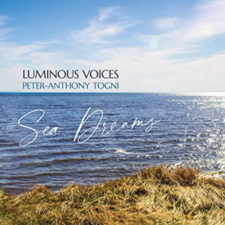
Review by: David Vernier

Artistic Quality: 8
Sound Quality: 9
Luminous Voices is a Calgary-based chamber choir founded in 2012 by Timothy Shantz, a conductor of wide experience both throughout Canada and internationally. His program here, performing works by another “contemporary” Canadian, Peter-Anthony Togni, proves a good choice, a nicely varied collection of pieces–nine in all–that reside comfortably in the realm of a certain branch of modern choral music (Gjeilo; Ešenvalds; even, in the opening work, Lauridsen and Whitacre), but happily also display an individuality that carries them above and beyond the familiar or derivative.
Totus Tuus is an ideal program opener, its clear, vibrant harmonies (a characteristic of many of Togni’s pieces) immediately catching the ear. The choir’s warmly expressive phrases create a sound and sensibility that’s not only emotionally engaging, but perfect in its rendering of this setting of the text (“I am wholly thine, Mary…”), so sublime in its simplicity. The same attributes of music and performance hold for Requiem et Lux, although this is a much longer piece with more contrasts of dynamics and varied textural effects. It’s another of the program’s highlights–and, I’m always impressed with a composer who knows how to write a great “Amen”!
In the title work, Sea Dreams, structured in three sections for two choirs and two flutes, Togni’s aspirations for the work–in both effect and affect–are greater than we actually are able to experience just from listening. In his notes Togni explains that it’s “a work that reflects my relationship with the ocean and my thoughts about a journey of faith…” He goes on to explain this in considerable detail, including the idea that each of the two choirs “represents a ship on the water”, passing in the night, and of seagulls following the ships, representing “the passage of time, angels, flowing thoughts…the Holy Spirit”.
This kind of thing always makes me ask the questions: “Exactly how does the music do that?”; “Am I actually supposed t0 ‘hear’ and/or ‘feel’ these things in the music?” I’m not really sure, but without reading the notes, I wouldn’t guess anything inherent in the music about ships or seagulls, or even about the sea, let alone any deeper meaning regarding the composer’s “journey of faith” or rather serious and complex relationship with the ocean. In its truest, purest form, music doesn’t work that way.
You might think that since this is vocal music, the text might provide the clues. But these selections–from T.S. Eliot’s “The Dry Salvages” and the Alma redemptoris from the Roman Catholic liturgy–don’t really help us understand, for all its sincerity, much about the composer’s philosophical concepts (learning to trust) and metaphorical images (life and human behavior) vis-à-vis the ocean. We do get flutes, two of them, pouring out reams of the kinds of “special effects” that must have made these very fine players happy, but that tends to overwhelm and dominate without any discernible purpose. Do they “represent” something?
While there’s lots of information on Sea Dreams, there’s nothing on the other works, such as Earth Voices, its evocative text by Canadian poet Bliss Carman (1861-1929). It’s an interesting and memorable piece (“Whisper, whisper/I heard the spring wind whisper/Above the brushwood fire…”) that features well-conceived and effectively employed percussion. Psaume 98 is a cool, catchy setting in French of “O sing unto the Lord a new song” that almost any choir would enjoy singing; Da Pacem Domine boasts rich, colorful harmonies owing to its skillful mix of textures and chord voicing–another choir (and audience) pleaser, with a powerful ending; Togni’s setting of the well-loved chant tune Of the Father’s Love Begotten is absolutely lovely, with another excellent “Amen”.
Two pieces feature a bass clarinet, and although soloist Jeff Reilly is really outstanding in both, other than for its distinctive timbre it’s hard to understand the choice of this instrument, as it often doesn’t integrate well with the voices. The final piece, Silentio, at more than seven minutes–and with its “endless” ending–is much too long for its material.
In the hope that perhaps these things will be corrected with future releases, I have to mention a couple of unnecessarily annoying packaging faults: there is no track listing inside the booklet (easily remedied by eliminating one of the group photos–or using smaller type!), which means constantly switching back and forth between booklet and outer package; there are no track timings anywhere–not essential, but a convenience, and a cost-less convention since the first days of the CD; the cover information, which doesn’t mention the choir director’s name anywhere, is confusing. But ultimately, you will worry less about these things as you listen, because the performances–by all concerned–are first-rate. Recommended.
Recording Details:
Album Title: Sea Dreams


